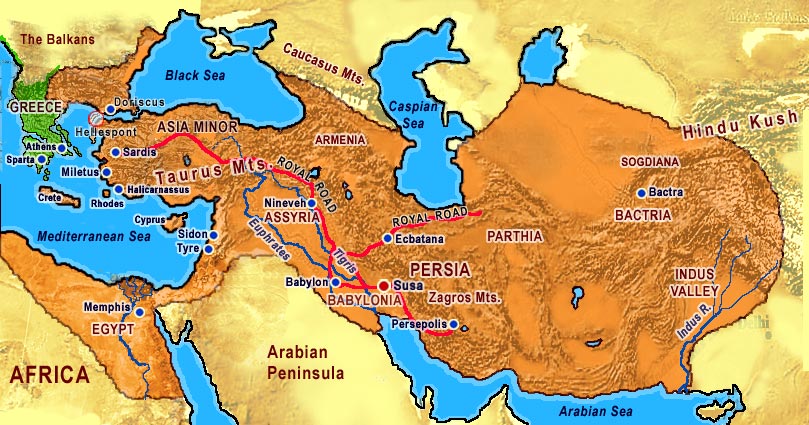
Esther
Book of Esther
Introduction
AUTHOR - We are not given the name of the writer of this book. It is possible
that Mordecai is the author; however, that is only conjecture.
TIME - The book of Esther takes place between the first and second returns of
Israel out of the land of Babylon. Below is a simple timeline.
1040 BC - King Saul
1000 BC - King David
722 BC - Israel fell to the Assyrians
587 BC - Judah fell to the Babylonians
539 BC - Persia conquers Babylon
538 BC - Cyrus allows Jews to return to Israel under Zerubabel (Ezra 1-6)
486 BC - King Ahasuerus
483 BC to 473 BC - Book of Esther \\#Esther 1:3\\
465 BC - King Ahasuerus assassinated
458 BC - Ezra leads a second return to Israel (Ezra 7-10)
445 BC - Nehemiah returned to Israel (Nehemiah)
THEME - The theme of Esther is “The Providence of God.” The book is unique in
many ways. One is that God’s name is not mentioned in the entire book. Another
is that the word “prayer” is not mentioned. Neither is their any reference to
the Jews offering sacrifices. Even so, God’s hand is clearly seen through out
the book.
J. Vernon McGee in his Thru the Bible series, Volume 15, makes mention of fact
that there should not have been any Jews left in Persia at this time. Cyrus had
given them permission to leave, and, some would say, God had given the Jews a
commandment to leave \\#Jer 51:6\\. That means those Jews who were still in Persian
(most of Jews remained), were out of the will of God. Even so, God providentially
watched over them to protect them.
PURPOSE - Esther tells the story of what happened to the Jews who stayed in
Babylon.
NAMES - King Ahasuerus is also know by the name Xerxes in the Bible. Both are
translations of the Persian name Khashayarsha.
CALENDAR - Esther is one of Megilloth (or Five Scroll) books. These are Old Testament
books (Ruth, Esther, Song of Solomon, Ecclesiastes, and Lamentations) which the Rabbis
read to the people on certain feast days. Below is this year’s calendar for the
Jews with the Megilloth feast days noted. Esther is read on Purim.
Rosh HaShanah: (Jewish New Year) September 19-20, 2009
Yom Kippur: (Day of Atonement) September 28, 2009 (Monday)
Sukkot: (Feast of Tabernacles) October 3-9, 2009 (Saturday through Friday))
The Rabbis read Ecclesiastes to the people.
Shemini Atzeret: October 10, 2009 (Saturday)
Simhat Torah: October 11, 2009 (Sunday)
Hanukkah (Chanukah): December 12-19, 2009 (Saturday through Saturday)
Tu Bishvat: January 30, 2010 (Saturday)
Purim: February 28, 2010 (Sunday)
The Rabbis read Esther to the people.
Passover (Pesach): March 30-April 6, 2010 (Tuesday through Tuesday)
The Rabbis read Song of Solomon to the people.
Holocaust Remembrance Day (Yom HaShoah): April 11, 2010 (Sunday)
Israel Memorial Day (Yom HaZikaron): April 18, 2010 (Sunday)
Israel Independence Day (Yom HaAtzmaut): April 19, 2010 (Monday)
Lag B’Omer: May 2, 2010 (Sunday)
Shavuot: (Pentecost or the Feast of Weeks) May 19-20, 2010 (Wednesday- Thursday)
The Rabbis read Ruth to the people.
Tisha B’Av: (Ninth of Av - The day Jerusalem was destroyed) July 20, 2010
(Tuesday) The Rabbis read Lamentations to the people.
(http://judaism.about.com/od/holidays/a/cal_09hol.htm)
MAP - The following maps shows the extent of the
Persian Empire.

OUTLINE
I. \\#Esther 1:1-22\\ The Wife Who Refused to Obey
II. \\#Esther 2:1-23\\ Choosing a New Queen
III. \\#Esther 3:1-15\\ Haman Forms A Plot
IV. \\#Esther 4:1-17\\ For Such A Time As This
V. \\#Esther 5:1-14\\ The Courage and Wisdom of Esther
VI. \\#Esther 6:1-14\\ A Sleepless Night In Persia
VII. \\#Esther 7:1-10\\ A Just Dessert
VIII. \\#Esther 8:1-17\\ Fixing A Wrong
IX. \\#Esther 9:1-32\\ An Overwhelming Victory
X. \\#Esther 10:1-3\\ The Conclusion